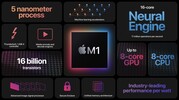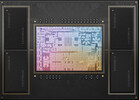Apple M1 vs Apple M2 Pro vs Apple M1 Pro
Apple M1
► remove from comparison
The Apple M1 is a System on a Chip (SoC) from Apple that is found in the late 2020 MacBook Air, MacBook Pro 13, and Mac Mini. It offers 8 cores divided in four performance cores and four power-efficiency cores. The big cores offer 192 KB instruction cache, 128 KB data cache, and 12 MB shared L2 cache. According to Apple the performance of these cores should be better than anything on the market (in late 2020). The four efficiency cores are a lot smaller and offer only 128 KB instruction cache, 64 KB data cache, and 4 MB shared cache. The efficiency cores (E cluster) clock with 600 - 2064 MHz, the performance cores (P cluster) with 600 - 3204 MHz.
The M1 is available in two TDP variants, a passive cooled 10 Watt variant for the MacBook Air and an active cooled faster variant for the MacBook Pro 13 and Mac Mini. Those should offer a better-sustained performance according to Apple.
The integrated graphics card in the M1 offers 8 cores (7 cores in the entry MacBook Air) and a peak performance of 2.6 teraflops. Apple claims that it is faster than any other iGPU at the time of announcement.
Furthermore, the SoC integrates a fast 16 core neural engine with a peak performance of 11 TOPS (for AI hardware acceleration), a secure enclave (e.g., for encryption), a unified memory architecture, Thunderbolt / USB 4 controller, an ISP, and media de- and encoders.
The Apple M1 includes 16 billion transistors (up from the 10 billion of the A12Z Bionic and therefore double the amount of a Tiger Lake-U chip like the i7-1185G7) and is manufactured in 5nm at TSMC.
Apple M2 Pro
► remove from comparison
The Apple M2 Pro is a System on a Chip (SoC) from Apple that is found in the early 2023 MacBook Pro 14 and 16-inch models. It offers all 12 cores available in the chip divided in eight performance cores (P-cores) and four power-efficiency cores (E-cores). The E-cores clock with up to 3.4 GHz, the P-Cores up to 3.7 GHz (mostly 3.3 GHz in multi-threaded workloads and 3.4 GHz in single threaded).
The big cores (codename Avalanche) offer 192 KB instruction cache, 128 KB data cache, and 36 MB shared L2 cache (up from 24 MB in the M1 Pro). The four efficiency cores (codename Blizzard) are a lot smaller and offer only 128 KB instruction cache, 64 KB data cache, and 4 MB shared cache. CPU and GPU can both use the 24 MB SLC (System Level Cache).
The unified memory (16 or 32 GB LPDDR5-6400) next to the chip is connected by a 256 Bit memory controller (200 GB/s bandwidth) and can be used by the GPU and CPU.
Apple states that the M2 Pro has a 25% higher performance than the M1 Pro in Xcode compiling.
The integrated graphics card in the M1 Pro offers all 19 cores.
Furthermore, the SoC integrates a fast 16 core neural engine (faster than M1 Pro), a secure enclave (e.g., for encryption), a unified memory architecture, Thunderbolt 4 controller, an ISP, and media de- and encoders (including ProRes).
The M2 Pro is manufactured in 5 nm at TSMC (second generation) and integrates 40 billion transistors.
Apple M1 Pro
► remove from comparison
The Apple M1 Pro is a System on a Chip (SoC) from Apple that is found in the late 2021 MacBook Pro 14 and 16-inch models. It offers all 10 cores available in the chip divided in eight performance cores (P-cores with 600 - 3220 MHz) and two power-efficiency cores (E-cores with 600 - 2064 MHz). There is no Turbo Boost for single cores or short burst periods. The cores are similar to the cores in the Apple M1. The entry level model offers only 8 cores.
The big cores (codename Firestorm) offer 192 KB instruction cache, 128 KB data cache, and 24 MB shared L2 cache (up from 12 MB in the M1). The four efficiency cores (codename Icestorm) are a lot smaller and offer only 128 KB instruction cache, 64 KB data cache, and 4 MB shared cache. CPU and GPU can both use the 24 MB SLC (System Level Cache). The efficiency cores (E cluster) clock with 600 - 2064 MHz, the performance cores (P cluster) with 600 - 3228 MHz.
The unified memory (16 or 32 GB LPDDR5-6400) next to the chip is connected by a 256 bit memory controller (200 GB/s bandwidth) and can be used by the GPU and CPU.
The integrated graphics card in the M1 Pro offers all 16 cores.
Furthermore, the SoC integrates a fast 16 core neural engine, a secure enclave (e.g., for encryption), a unified memory architecture, Thunderbolt 4 controller, an ISP, and media de- and encoders (including ProRes).
The M1 Pro is manufactured in 5 nm at TSMC and integrates 33.7 billion transistors. The peak power consumption of the chip was advertised around 30W for CPU intensive tasks. In the Prime95 benchmark the chip uses in our tests (with a MBP16) 33.6W package power and 31W for the CPU part. In idle the SoC only reports 1W package power.
| Model | Apple M1 | Apple M2 Pro | Apple M1 Pro | ||||||||||||||||||||||||||||||||||||||||||||||||
| Series | Apple M1 | Apple M2 | Apple M1 | ||||||||||||||||||||||||||||||||||||||||||||||||
| Series: M1 |
|
|
| ||||||||||||||||||||||||||||||||||||||||||||||||
| Clock | 2064 - 3220 MHz | 2424 - 3504 MHz | 2064 - 3220 MHz | ||||||||||||||||||||||||||||||||||||||||||||||||
| L1 Cache | 2 MB | 3.3 MB | 2.9 MB | ||||||||||||||||||||||||||||||||||||||||||||||||
| L2 Cache | 16 MB | 36 MB | 28 MB | ||||||||||||||||||||||||||||||||||||||||||||||||
| L3 Cache | 8 MB | 24 MB | 24 MB | ||||||||||||||||||||||||||||||||||||||||||||||||
| Cores / Threads | 8 / 8 | 12 / 12 | 10 / 10 | ||||||||||||||||||||||||||||||||||||||||||||||||
| Transistors | 16000 Million | 40000 Million | 33700 Million | ||||||||||||||||||||||||||||||||||||||||||||||||
| Technology | 5 nm | 5 nm | 5 nm | ||||||||||||||||||||||||||||||||||||||||||||||||
| Features | ARMv8 Instruction Set | ARMv8 Instruction Set | ARMv8 Instruction Set | ||||||||||||||||||||||||||||||||||||||||||||||||
| iGPU | Apple M1 8-Core GPU | Apple M2 Pro 19-Core GPU | Apple M1 Pro 16-Core GPU | ||||||||||||||||||||||||||||||||||||||||||||||||
| Architecture | ARM | ARM | ARM | ||||||||||||||||||||||||||||||||||||||||||||||||
| Announced |
Benchmarks
Average Benchmarks Apple M1 → 100% n=16
Average Benchmarks Apple M2 Pro → 147% n=16
Average Benchmarks Apple M1 Pro → 126% n=16
* Smaller numbers mean a higher performance
1 This benchmark is not used for the average calculation













